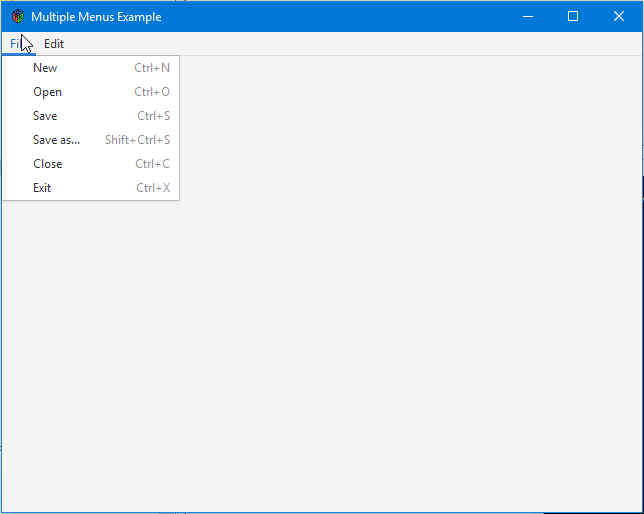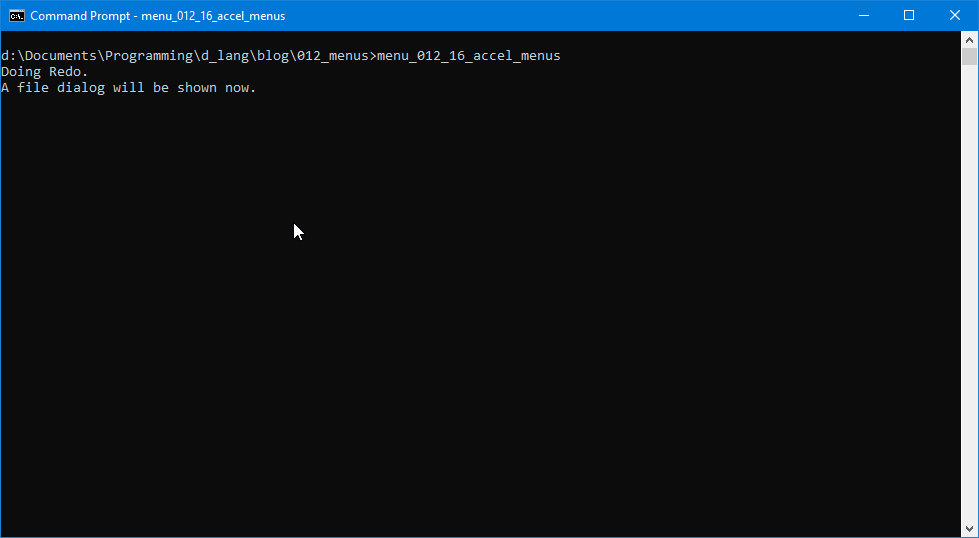0032: Menus VII - Adding Accelerator Keys to MenuItems


Imports
First things first… We need the AccelGroup class and a couple of enums, so we bring them in:
import gtk.AccelGroup;
import gdk.c.types;
Make note: That’s another gdk not gtk library and from that we get these enums:
AccelFlags
VISIBLE(shows on theMenuItem), andLOCKED(can’t be remapped on the fly).
ModifierType
SHIFT_MASK(Shift key),LOCK_MASK(usually the Caps Lock key),CONTROL_MASK(Control Key), andMOD1_MASK(usually the Alt key).
We’ll get to their use in a moment, but right now let’s take a quick look at…
The AccelGroup
Because all accelerator keys are used when the Window has focus, the AccelGroup needs to be declared in, instantiated in, and added to the Window object:
class TestRigWindow : MainWindow
{
string title = "Multiple Menus Example";
AccelGroup accelGroup;
this()
{
super(title);
setDefaultSize(640, 480);
addOnDestroy(&quitApp);
accelGroup = new AccelGroup();
addAccelGroup(accelGroup);
AppBox appBox = new AppBox(accelGroup);
add(appBox);
showAll();
} // this()
void quitApp(Widget w)
{
// do other exit stuff here if necessary
Main.quit();
} // quitApp()
} // TestRigWindow
Notice also that it gets passed to the AppBox constructor which passes it along to the MyMenuBar constructor, then FileMenuHeader, FileMenu, EditMenu, etc. down the line until it’s available to each individual MenuItem constructor like this:
class ExitItem : MenuItem
{
string itemLabel = "Exit";
char accelKey = 'q';
this(AccelGroup accelGroup)
{
super(&doSomething, itemLabel, "activate", true, accelGroup, accelKey, ModifierType.CONTROL_MASK, AccelFlags.VISIBLE);
//addOnActivate(&doSomething);
} // this()
void doSomething(MenuItem mi)
{
writeln("Quitting... Bye.");
Main.quit();
} // exit()
} // class ExitItem
A less cumbersome way to do this would be with a singleton, but we’ll have that discussion next week.
Another thing to note: Instead of connecting the callback here, we pass it to the super-class. I left the addOnActivate() line there—just commented out—as a reminder. Naturally, you can un-comment it to see what happens.
What are all those Arguments?
The major departure from earlier examples is, as mentioned, the call to the super-class. One by one, they are…
Delegate
This is exactly the same argument we would pass to a signal hook-up function, which is the name of the callback function, preceded by an ampersand (&).
void delegate(MenuItem) dlg
In this case, it’s: &doSomething.
Label
This is the text that’ll appear on the MenuItem:
string label
And for us (have a look at the initialization section of this class) it ends up being "Exit".
Action
This next argument takes the place of assigning a signal when dealing with a MenuItem:
string action
I can think of no reason to use any signal other than “activate”… although you might. (And if you do, please post about it either on the D Language forum or the GtkD forum so we can all add a new technique to our toolbox.)
Mnemonic
No need to get deep here, just set this to true:
bool mnemonic
AccelGroup
This is what we passed down from the RigTestWindow, the object that connects all the keyboard shortcuts to the application’s Window:
AccelGroup accelGroup
The Keyboard Shortcut Itself
This is the letter key used in combination with ModifierType (the next argument) to designate the entire keyboard shortcut:
char accelKey
And for our example here, it’s 'q' for Exit… Well, the standard is Quit, but whatever.
ModifierType
This decides which qualifier key is held while pressing the letter key:
ModifierType.<MODIFIER>
These take the form of ModifierType.CONTROL_MASK or ModifierType.SHIFT_MASK and can be OR’ed together like this: ModifierType.CONTROL_MASK | ModifierType.SHIFT_MASK | ModifierType.MOD1_MASK if you want someone to hold down Ctrl-Alt-Shift-KEY. We looked at the possible values for ModifierType right at the beginning of this post (in case you need to refer back).
AccelFlags
And lastly, the AccelFlags argument:
AccelFlags.VISIBLE
This flag is optional and you can actually leave it out. It’s main use seems to be AccelFlags.LOCKED which is used when you don’t want users messing with your shortcut keys.
Conclusion
So, yeah, it takes a bit of extra coding to make these work:
- from stuffing an
AccelGroupinto your mainWindow, - passing it all the way down to the
MenuItemobjects so they have access when they instantiate, and - coming up with that long list of arguments to pass to the super-class constructor.
But your users will thank you. And speaking of thanks…
Thanks for reading and do please come back for the next post. Until then…
Comments? Questions? Observations?
Did we miss a tidbit of information that would make this post even more informative? Let's talk about it in the comments.
- come on over to the D Language Forum and look for one of the gtkDcoding announcement posts,
- drop by the GtkD Forum,
- follow the link below to email me, or
- go to the gtkDcoding Facebook page.
You can also subscribe via RSS so you won't miss anything. Thank you very much for dropping by.
© Copyright 2025 Ron Tarrant
